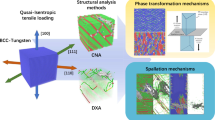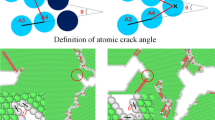Abstract
The propagation of a pre-existing center crack in single crystal tungsten under cyclic loading was examined by molecular dynamics (MD) simulations at various temperatures. The results indicated that the deformation mechanism and fracture behavior at crack tip were differences for variously oriented cracks. The [001](010) crack propagated as the form of the formation of slip, while the deformation mechanisms of [10–1](101) crack were blunting voids at 300 K. At higher temperature, many more slip systems were activated resulting in the change of mode of crack propagation. Simulated results showed that the effect of temperature on deformation mechanism and fracture behavior of [001](010) crack was more sensitive than that of [10–1](101) crack. Meanwhile, the influence of a 5〈310〉{110} model grain boundary (GB) on crack propagation was also discussed. Detailed analysis showed that the grain boundary resisted the crack growth by changing the deformation mechanisms and the path of crack propagation at crack tip before the crack reached the grain boundary, and had an important influence on the crack growth rate.








Similar content being viewed by others
References
Y. Cheng, M. Mrovec, and P. Gumbsch: Crack nucleation at the Σ9(221) symmetrical tilt grain boundary in tungsten. Mater. Sci. Eng., A 483(4), 329 (2008).
Y. Zhang, A.V. Ganeev, J.T. Wang, J.Q. Liu, and I.V. Alexandrov: Observations on the ductile-to-brittle transition in ultrafine-grained tungsten of commercial purity. Mater. Sci. Eng., A 503, 37 (2009).
S.N. Mathaudhu, A.J. deRosset, K.T. Hartwig, and L.J. Kecskes: Microstructures and recrystallization behavior of severely hot-deformed tungsten. Mater. Sci. Eng., A 503, 28 (2009).
A. Alfonso, D. Juul Jensen, G.N. Luo, and W. Pantleon: Recrystallization kinetics of warm-rolled tungsten in the temperature range 1150–1350 °C. J. Nucl. Mater. 455, 591 (2014).
A. Alfonso, D. Juul Jensen, G.N. Luo, and W. Pantleon: Thermal stability of a highly-deformed warm-rolled tungsten plate in the temperature range 1100–1250 °C. Fusion Eng. Des. 98–99, 1924 (2015).
X.Y. Tan, L.M. Luo, Z.L. Lu, G.N. Luo, X. Zan, J.G. Cheng, and Y.C. Wu: Development of tungsten as plasma-facing materials by doping tantalum carbide nanoparticles. Powder Technol. 269, 437 (2015).
G.P. Potirniche, J.L. Hearndon, M.F. Horstemeyer, and X.W. Ling: Lattice orientation effects on void growth and coalescence in fcc single crystals. Int. J. Plast. 22(5), 921 (2006).
Y.F. Guo and D.L. Zhao: Atomistic simulation of structure evolution at a crack tip in bcc-iron. Mater. Sci. Eng. 448(1–2), 281 (2007).
T. Tang, S. Kim, and M.F. Horstemeyer: Fatigue crack growth in magnesium single crystals under cyclic loading: Molecular dynamics simulation. Comput. Mater. Sci. 48(2), 426 (2010).
H. Xie, T. Yu, F. Yin, and C. Tang: The effects of crack orientation on the twin formation from the crack tip in γ-Ni3Al. Mater. Sci. Eng., A 580, 99 (2013).
L. Ma, S.F. Xiao, H.Q. Deng, and W.Y. Hu: Atomic simulation of fatigue crack propagation in Ni3Al. Appl. Phys. A 118, 1399 (2015).
H. Lee and V. Tomar: Understanding effect of grain boundaries in the fracture behavior of polycrystalline tungsten under mode-I loading. J. Eng. Mater. Technol. 134(3), 031010 (2012).
L. Ma, S.F. Xiao, H.Q. Deng, and W.Y. Hu: Molecular dynamics simulation of fatigue crack propagation in bcc iron under cyclic loading. Int. J. Fatigue 68, 253 (2014).
G.P. Potirniche, M.F. Horstemeyer, B. Jelinek, and G.J. Wagner: Fatigue damage in nickel and copper single crystals at nanoscale. Int. J. Fatigue 27, 1179 (2005).
A. Machová, J. Pokluda, A. Uhnáková, and P. Hora: 3D atomistic studies of fatigue behaviour of edge crack (001) in bcc iron loaded in mode I and II. Int. J. Fatigue 66, 11 (2014).
K.J. Zhao, C.Q. Chen, Y.P. Shen, and T.J. Lu: Molecular dynamics study on the nano-void growth in face-centered cubic single crystal copper. Comput. Mater. Sci. 46(3), 749 (2009).
E. Gaganidze, D. Rupp, and J. Aktaa: Fracture behaviour of polycrystalline tungsten. J. Nucl. Mater. 446(s1–3), 240 (2014).
X. Yu, F. Gou, B. Li, and N. Zhang: Numerical study of the effect of hydrogen on the crack propagation behavior of single crystal tungsten. Fusion Eng. Des. 89, 1096 (2014).
Y. Zhang, F.C. Zhang, L.H. Qian, and T.S. Wang: Atomic-scale simulation of iron phase boundary affecting crack propagation using molecular dynamics method. Comput. Mater. Sci. 50(5), 1754 (2011).
Online source: National Institute of Standards and Technology: 2017. Available at: http://www.ctcms.nist.gov/potentials/ (accessed 05 March 2016).
S. Han, L.A. Zepeda-Ruiz, G.J. Ackland, R. Car, and D.J. Srolovitz: Interatomic potential for vanadium suitable for radiation damage simulations. J. Appl. Phys. 93(6), 3328 (2003).
S. Plimpton: Fast parallel algorithms for short-range molecular dynamics. J. Comput. Phys. 117, 1 (1995).
C. Kittel: Introduction to Solid State Physics, 7th ed. (Wiley Press, New York, 1996); p. 57.
K. Maier, M. Peo, B. Saile, H.E. Schaefer, and A. Seeger: High-temperature positron annihilation and vacancy formation in refractory metals. Philos. Mag. A 40, 701 (1979).
H.J. Wollenberger: Point defects. Phys. Metall. 2, 1139 (1983).
D.I. Bolef and J. De Klerk: Elastic constants of single-crystal Mo and W between 77° and 500° K. J. Appl. Phys. 33(7), 2311 (1962).
G. Bonny, D. Terentyev, A. Bakaev, P. Grigorev, and D. Van Neck: Many-body central force potentials for tungsten. Modell. Simul. Mater. Sci. Eng. 22(22), 053001 (2014).
W.R. Tyson and W.A. Miller: Surface free energies of solid metals: Estimation from liquid surface tension measurements. Surf. Sci. 62(1), 267 (1977).
G.B. Bachelet, D.R. Hamann, and M. Schluter: Pseudopotentials that work: From H to Pu. Phys. Rev. B: Condens. Matter Mater. Phys. 26, 4199 (1982).
S. Giusepponi and M. Celino: The ideal tensile strength of tungsten and tungsten alloys by first-principles calculations. J. Nucl. Mater. 435, 52 (2013).
Z. Chen, L.J. Kecskes, K. Zhu, and Q. Wei: Atomistic simulations of the effect of embedded hydrogen and helium on the tensile properties of monocrystalline and nanocrystalline tungsten. J. Nucl. Mater. 481, 190 (2016).
Y.L. Liu, H.B. Zhou, Y. Zhang, S. Jin, and G.H. Lu: The ideal tensile strength and deformation behavior of a tungsten single crystal. Nucl. Instrum. Methods Phys. Res. 267(18), 3282 (2009).
A. Kelly and N.H. Macmillan: Strong Solids, Vol. 1015, 3rd ed. (Clarendon Press, Oxford, 1986).
A. Stukowski: Visualization and analysis of atomistic simulation data with OVITO–the open visualization tool. Modell. Simul. Mater. Sci. Eng. 18(1), 015012 (2010).
J.D. Honeycutt and H.C. Andersen: Molecular dynamics study of melting and freezing of small Lennard–Jones clusters. J. Phys. Chem. 91(19), 4950 (1987).
B. Gludovatz, S. Wurster, A. Hoffmann, and R. Pippan: A study into the crack propagation resistance of pure tungsten. Eng. Fract. Mech. 100, 76 (2013).
D. Hull, P. Beardmore, and A.P. Valintine: Crack propagation in single crystals of tungsten. Philos. Mag. 12(119), 1021 (1965).
J.P. Hirth and J. Lothe: Theory of Dislocations (Wiley-Interscience Press, New York, 1982); p. 764.
K. Nishimura and N. Miyazaki: Molecular dynamics simulation of crack growth under cyclic loading. Comput. Mater. Sci. 31, 269 (2014).
P. Wang, J.G. Xu, Y.G. Zhang, and H.Y. Song: Molecular dynamics simulation of effect of grain on mechanical properties of nano-polycrystal alpha-Fe. Acta Phys. Sin. 65, 236201 (2016).
L. Yan and J.K. Fan: In situ SEM study of fatigue crack initiation and propagation behavior in 2524 aluminum alloy. Mater. Des. 110, 592 (2016).
ACKNOWLEDGMENTS
This work is supported by the National Magnetic Confinement Fusion Science Program of China (Grant No. 2014GB104002), the National Natural Science Foundation of China (Grant No. U1530151, 51471068), and the Specialized Research Fund for the Doctoral Program of Higher Education of China (Grant No. 20120161110015). We also appreciate the support by Atomic Simulation Lab of Hunan University and the computation platform of National Supper-Computer Center in Changsha.
Author information
Authors and Affiliations
Corresponding authors
Rights and permissions
About this article
Cite this article
Shu, XT., Xiao, Sf., Deng, Hq. et al. Atomistic simulation of crack propagation in single crystal tungsten under cyclic loading. Journal of Materials Research 32, 1474–1483 (2017). https://doi.org/10.1557/jmr.2017.114
Received:
Accepted:
Published:
Issue Date:
DOI: https://doi.org/10.1557/jmr.2017.114




